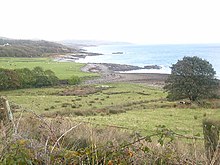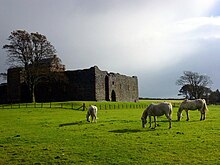Kintyre


Kintyre, is a long, narrow peninsula in Argyllshire which divides the Hebrides from the Firth of Clyde, of which it forms the western wall. Kintyre itself stretches some 30 miles from East Loch Tarbert in the north down to the Mull of Kintyre in the south. The region immediately north of Kintyre is known as Knapdale, and if Knapdale is included then the peninsula is as long again.
The name "Kintyre" is Gaelic, in which it is Cinn Tìre.
Kintyre is long and narrow; at its broadest it is 11 miles from its west to its east coast, and most of the reach of the land is eight miles across. Between the coasts the central spine of the peninsula is hilly moorland; a great, long mountain whose peaks rise up, reaching 1,490 feet high at Beinn an Tuirc.
The coastal areas and hinterland are rich and fertile. As such, Kintyre has long been a prized area for settlers, including the early Scots who migrated from Ulster to western Scotland and the Norsemen who conquered and settled the area just before the start of the second millennium.
The east side of the Kintyre Peninsula is bounded by Kilbrannan Sound, and is marked by a number of coastal peaks such as Torr Mor.
The principal town of Kintyre is Campbeltown, about 5½ miles by road from the Mull, which has been a royal burgh since the mid-18th century. The area's economy has long relied on fishing and farming, although Campbeltown has a reputation as a producer of some of the world's finest single malt whisky. Campbeltown Single Malts.
The peninsula has given its name to the Kintyre Pursuivant of Arms in Ordinary; one of the officers of arms at the Court of the Lord Lyon.
Towns and villages in Kintyre


- Bellochantuy
- Campbeltown
- Carradale
- Clachan
- Claonaig
- Drumlemble
- Glenbarr
- Grogport
- Kilchenzie
- Machrihanish
- Muasdale
- Peninver
- Saddell
- Skipness
- Southend
- Stewarton
- Tayinloan
- Tarbert,
- Whitehouse.
Magnus Barefoot makes Kintyre an island
In the late 11th century, according to the Norse sagas, King Magnus III of Norway ("Magnus Barefoot") forced upon the King of the Scots a treaty whereby all the islands off the west coast of Scotland between which and the mainland he could pass in a vessel with her rudder shipped, should be held to belong to the king of Norway. The King then had a skiff drawn across the mile-broad isthmus in the north of Kintyre between East Loch Tarbert and West Loch Tarbert while he sat at the helm with the tiller in his hand. Thus he could claim possession of Kintyre as an island.[1] (The same trick was played, according to the Orkneyinga Saga, by the legendary sea-king Beiti to claim a peninsula at Namdalseid in Norway.)
Magnus declared that Kintyre had "better land than the best of the Hebrides", it remained under Norse rule for more than a dozen years after Magnus "sailed" around it. [2][3][4][5]
The Norse sagas assert that the arrangement was made with King Malcolm, but this would in fact have been at the beginning of the reign of King Edgar of Scotland[6]
Mull of Kintyre


The Mull is the great headland at the south end of the peninsula. It was made world-famous in 1977 by Paul McCartney's eponymous song.
The Mull is the end of the high, rounded hill which makes the southernmost and broadest part of Kintyre. The Mull itself is the south-westernmost tip of Kintyre where Beinn na Lice tumbles down to the sea, some 10 miles from Campbeltown and 8 miles beyond the southernmost village of the peninsula, Southend, from which a single-track road winds up to the top of Beinn na Lice.
Ailsa Craig and the Antrim coast and Rathlin Island are all clearly visible from the Mull. On clearer days it is also possible to make out Malin Head in County Donegal, and the Ayrshire coast beyond Ailsa Craig. Other islands in the Firth of Clyde are also visible when looking east, especially from further back along the single track road from Southend village. At its closest point, mainland Antrim is only 12 miles from the Mull. Owing to the low-lying level of Rathlin Island and the high elevation of the Mull of Kintyre it is also possible to see over the top of Rathlin Island and on towards the Antrim coastal town of Ballycastle, immediately behind. Visitors to the Mull may also see the individual houses of the Antrim coast and the cars travelling along the coast road without the aid of binoculars, although this is dependent on having very good visibility; the area is often being plagued with sea-mists.
Notoriously strong currents plague the tip of the Kintyre Peninsula, prohibiting swimmers and creating a hazard to unmotorised craft. The steep sides rising out of the sea on all sides have made the area a hazard to flight too: the remains of a number of Second World War planes litter the area.
Lighthouse
The Mull of Kintyre Lighthouse was the second lighthouse commissioned in Scotland by the Commissioners of the Northern Lights. It was designed and built by Thomas Smith and completed in 1788; Smith had previously designed the light at Kinnaird Head, but Mull of Kintyre was a far more substantial project, in a far more remote location.
The lighthouse was rebuilt in the 1820s. The light was fixed until 1906, when it was converted to flash, and its power increased from 8,000 to 281,000 candlepower. It was converted to electrical power in 1976, automated in 1996 and is now monitored from Edinburgh.
The former keeper's cottages are now run as holiday cottages by the National Trust for Scotland.
Ferries
- Caledonian MacBrayne sail:
- Claonaig - Lochranza (in Summer)
- Kennacraig - Islay
- Tarbert - Lochranza (in Winter)
- Tarbert - Portavadie
- Tayinloan - Gigha
- Kintyre Express sail:
- Campbeltown - Troon (starting May 2006)
- Closed: The route from Campbeltown to Ballycastle, opened with much fanfare and taxpayer's money, was closed soon after, in 2002 and though much discussed, there is no sign of its being reopened.
Places of historic interest

- Clachan Church - carved mediæval grave slabs
- Kilchenzie church
- Kilchousland Chapel, near Peninver
- Kilcomkill, Southend - St Columba's Chapel, carved grave slabs, "St. Columba's footprints" nearby
- Killean - St. John's Church - "most important mediæval parish church in Kintyre"[7] - carved grave slabs
- 18th century Killean and Kilchenzie Church (united parish) at A'Chleit
- Saddell Abbey
- Saddell Castle
- Skipness Castle
- Tarbert Castle
Prehistoric sites
- Avinagillan standing stone
- Ballochroy standing stones
- Beacharr standing stone, near Tayinloan
- Corriechrevie cairn - intact
- Dun Skeig - Iron Age forts near Clachan
- Kildonan galleried dun
Popular culture
- Paul McCartney's song Mull of Kintyre performed by Wings was written in tribute to the picturesque peninsula, where McCartney has owned High Park Farm since 1966, and its headland or Mull of Kintyre. The song was Wings' biggest hit in the United Kingdom where it became Christmas number one, and was the first single to sell over two million copies in the United Kingdom.
Outside links
- Kintyre.org - Official visitor and tourist information website for Kintyre
- VisitKintyre.info - Web Site including webcam, accommodation, news, photo galleries etc
- KIntyre.biz - Visitor information, accommodation, photos and much more
References
- ↑ Magnus Barefoot's Saga and the Orkneyinga Saga
- ↑ "West Loch Tarbert" Gazetteer for Scotland. Retrieved 13 September 2008.
- ↑ "Magnus's Saga", chapter 10 in Hollander (1964) pp. 676–677
- ↑ Murray (1977) p. 100 has the date as 1093
- ↑ "Tarbert History" Tarbert.info. Retrieved 13 September 2008.
- ↑ Woolf, Alex "The Age of the Sea-Kings: 900-1300" in Omand (2006) p. 101
- ↑ Newton, Norman S (1999). Kintyre.